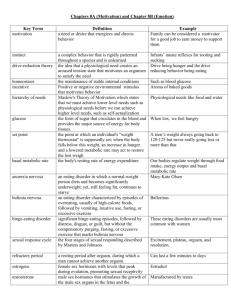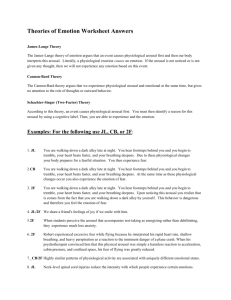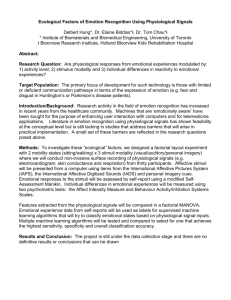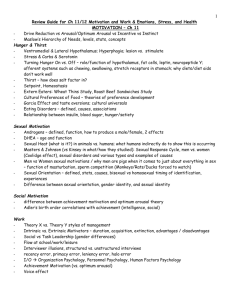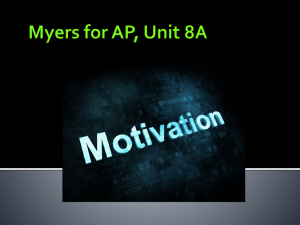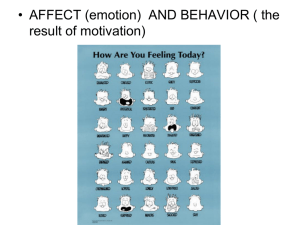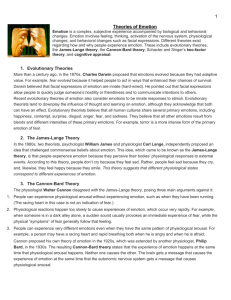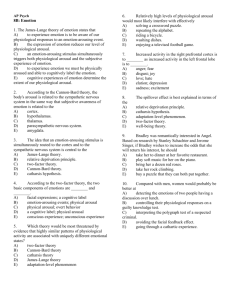Name Class ______ Chapter 6 & 7 Take Home Test Directions
advertisement
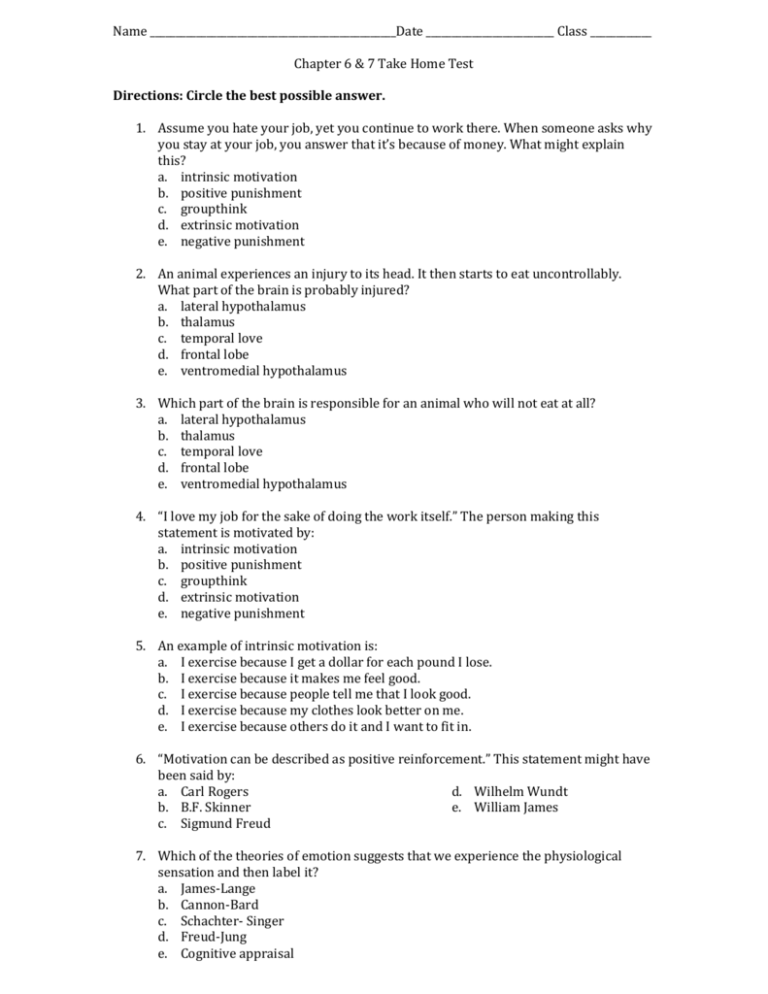
Name ________________________________________________Date _________________________ Class ____________ Chapter 6 & 7 Take Home Test Directions: Circle the best possible answer. 1. Assume you hate your job, yet you continue to work there. When someone asks why you stay at your job, you answer that it’s because of money. What might explain this? a. intrinsic motivation b. positive punishment c. groupthink d. extrinsic motivation e. negative punishment 2. An animal experiences an injury to its head. It then starts to eat uncontrollably. What part of the brain is probably injured? a. lateral hypothalamus b. thalamus c. temporal love d. frontal lobe e. ventromedial hypothalamus 3. Which part of the brain is responsible for an animal who will not eat at all? a. lateral hypothalamus b. thalamus c. temporal love d. frontal lobe e. ventromedial hypothalamus 4. “I love my job for the sake of doing the work itself.” The person making this statement is motivated by: a. intrinsic motivation b. positive punishment c. groupthink d. extrinsic motivation e. negative punishment 5. An example of intrinsic motivation is: a. I exercise because I get a dollar for each pound I lose. b. I exercise because it makes me feel good. c. I exercise because people tell me that I look good. d. I exercise because my clothes look better on me. e. I exercise because others do it and I want to fit in. 6. “Motivation can be described as positive reinforcement.” This statement might have been said by: a. Carl Rogers d. Wilhelm Wundt b. B.F. Skinner e. William James c. Sigmund Freud 7. Which of the theories of emotion suggests that we experience the physiological sensation and then label it? a. James-Lange b. Cannon-Bard c. Schachter- Singer d. Freud-Jung e. Cognitive appraisal 8. Which theory of emotion suggests that we experience the emotion first and then have a physiological response? a. James-Lange b. Cannon-Bard c. Schachter-Singer d. Freud-Jung e. Cognitive appraisal 9. When asked why he wants to become a doctor, Tom says, “Because I’ve always liked biology and being a doctor will allow me to make a good salary in order to take care of my family.” His answer is most consistent with which of the following theories of motivation? a. Drive-Reduction Theory b. Incentive Theory c. Maslow’s Hierarchy of Needs d. Expectancy-Value Theory e. Instinct Theory 10. The James-Lange Theory of Emotion states that a. emotional awareness precedes our physiological response to a stressful event b. emotional expression follows awareness of our physiological response to an arousing event c. an arousing event simultaneously triggers both a cognitive awareness and a physiological response d. the level of fear we first feel when we ride a roller coaster is reduced each time we experience the same event until thrill replaces it e. when we are unaware of why we are feeling arousal, we take cues from our environment 11. Homeostasis refers to a. arousal of the sympathetic nervous system b. a tendency for individuals to behave consistently when highly motivated c. a need state resulting from the physiological experience of hunger or thirst d. the body’s tendency to maintain a balanced internal state 12. During middle school, the typical student is preoccupied with making friends. According to Maslow’s Hierarchy of Needs, which of the following needs is he/she satisfying? a. physiological needs e. self-actualization b. safety/security needs c. love/belonging needs d. esteem needs 13. Which of the following most accurately reflects our current understanding of the basic facial expressions? a. Facial expressions are universally recognized and displayed by all cultures. b. Anger is easily interpreted as a facial expression by most cultures and displayed by all in similar situations. c. Facial expressions are universally recognized, but highly variable in how they are displayed. d. Cultures vary in their interpretation and display of the six most common facial expressions. e. Facial expressions are learned through modeling of basic facial expressions by parents. 14. Internal and external factors that direct an organism’s behavior towards a desired outcome is referred to as a. emotion b. homeostasis c. motivation d. arousal e. behavior 15. Mrs. Bird got up in the middle of the night for a drink of water. Which theory of motivation best explains why she got out of bed? a. Instinct theory b. James-Lange theory c. Drive-Reduction Theory d. Self-actualization e. Opponent-Process Theory 16. According to Abraham Maslow, _________________ is/are at the top of the hierarchy of needs. a. love and belonging needs b. safety needs c. self-actualization d. esteem needs e. physiological needs 17. When Julia heard a noise outside her window, her heart started to beat faster. As a result, she became scared. Which theory of emotion could best explain Julie’s response of fear? a. Cannon-Bard b. James-Lange c. Schachter-Singer d. Opponent-Process e. Facial-Feedback 18. ________________ is the idea that physiological needs create an aroused state that motivates an organism to reduce that need. a. Drive-Reduction Theory c. Hierarchy of Needs b. Arousal Theory d. Opponent-Process Theory 19. Abraham Maslow’s hierarchy of needs is a framework that a. aims to eliminate arousal b. explains our homeostasis system c. helps to describe human motivation d. helps people reach self-transcendence e. is universally fixed 20. While walking down the street, you are approached by a man with a gun who demands your money. According to the Schachter-Singer Two Factor Theory of Emotion, you are most likely to conclude that a. since your heart is pounding in this dangerous situation, you must be afraid b. you are afraid because your heart is pounding c. your heart is pounding because you are afraid d. it is alright to be afraid in this situation 21. Explain the Glucostatic Theory of Motivation. 22. In Schachter’s experiment involving obesity, what were his conclusions? (Hint: Look at pages 135, 136 in your book.) 23. What is the Drive-Reduction Theory? Who came up with it? In what year? 24. What two major things did Harlow conclude from his experiment involving monkeys? 25. Draw a picture of Abraham Maslow’s Hierarchy of Needs. Be sure to include all appropriate labels and give an example of each stage. (5 points) 26. What were the results of Schachter and Singer’s experiment from 1962? (Hint: Page 148 in your book.) 27. Summarize the sleep process. Name the stage and explain what happens in each stage of sleep. (5 points) 28. Who is Francis Crick, why does he matter, and what does he say about dreams? 29. What did Herbert Benson’s book The Relaxation Response argue? 30. What was Freud’s view on the meaning of dreams?


